It's coming along:
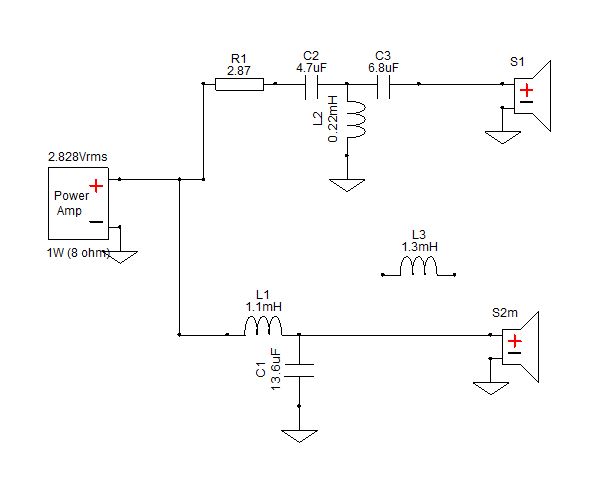
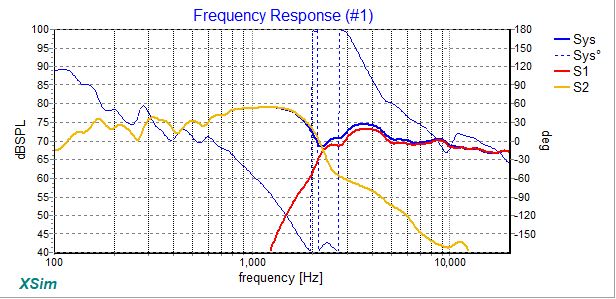
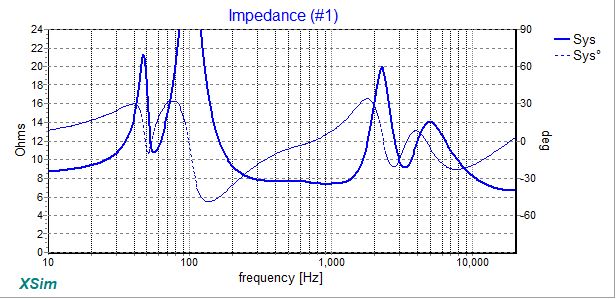
Dayton Audio - PC83-4 3" Full-Range Poly Cone Driver
Dayton Audio - TD20F-4 3/4" Soft Dome Neodymium Tweeter 4 Ohm
Try a 1.8mH bass coil and 4.7uf or 6.8uF shunt now. And Closed box around 5L overall. I am a bit surprised at the tweeter response. It should be flatter. Phase is poor too. It should be louder too. I'd expect the (90dB) tweeter filter to have a bigger resistor too. Those woofers are only 86dB.
Old reliable on tweeter filters is resistor then 3.3uF/0.22mH/10uF.
Dayton Audio - PC83-4 3" Full-Range Poly Cone Driver
Dayton Audio - TD20F-4 3/4" Soft Dome Neodymium Tweeter 4 Ohm
Try a 1.8mH bass coil and 4.7uf or 6.8uF shunt now. And Closed box around 5L overall. I am a bit surprised at the tweeter response. It should be flatter. Phase is poor too. It should be louder too. I'd expect the (90dB) tweeter filter to have a bigger resistor too. Those woofers are only 86dB.
Old reliable on tweeter filters is resistor then 3.3uF/0.22mH/10uF.
Ill try that thankyou, the box is already made, its ported, i cant recall the volume right now though, i made them months ago. The tweeter spl is probably due to the volume i used when i measured the drivers, i just played the tone and turned the amp up until it read 80db, the resistor i added to the tweeter dropped it almost 10db. The phase is what omnimic produced, i messed with derived phase on xsim by adjusting the tails on one attempt but couldnt figure out what was good or bad so i decided to just use the measured phase data that it recorded,
I dont know how accurate my measurements are tbh, i had big problems with faulty frd graphs due to my laptop colouring the sound, i swapped to using a cd player with no built in EQ for the last set of measurements but ive no way to tell if my graph is actually accurate, im really trying to learn all of this but it seems very hard when it comes to the crossover and understanding the parts needed and what they do, also knowing what min and max values i need in certain arrangements
Also i need to crossover around 3800-4500, preferably higher, but every time i go that high the response or impedance goes out of whack. Im considering replacing the tweeters for better ones because im losing all hope with this one
I dont know how accurate my measurements are tbh, i had big problems with faulty frd graphs due to my laptop colouring the sound, i swapped to using a cd player with no built in EQ for the last set of measurements but ive no way to tell if my graph is actually accurate, im really trying to learn all of this but it seems very hard when it comes to the crossover and understanding the parts needed and what they do, also knowing what min and max values i need in certain arrangements
Also i need to crossover around 3800-4500, preferably higher, but every time i go that high the response or impedance goes out of whack. Im considering replacing the tweeters for better ones because im losing all hope with this one
Last edited:
Oh, I made a goof there. The tweeter is 4 ohms not 6...
Easily adjusted. Put a 2.2R in front of it and it is now a 6 ohm circuit:
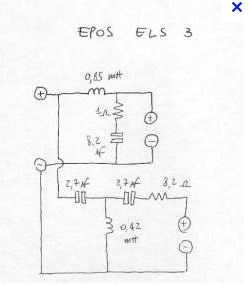
Quite a common practice:
Vifa PL14WJ-
Easily adjusted. Put a 2.2R in front of it and it is now a 6 ohm circuit:
Quite a common practice:
Vifa PL14WJ-
Dameo182,
developing speakers can be a reiterating process, so when you perform measurements, do as well horizontal off-axis measurements to check how things are going there. It is advisable to have a stash of passive parts in order to evaluate alternate x/o configurations. Otherwise your initial schematic is reasonably good to get you started.
developing speakers can be a reiterating process, so when you perform measurements, do as well horizontal off-axis measurements to check how things are going there. It is advisable to have a stash of passive parts in order to evaluate alternate x/o configurations. Otherwise your initial schematic is reasonably good to get you started.
Sorry, im a bit confused now, im not sure what the shunt is, and was the sketched picture just an example? Ive input the design of that sketch but the graph is almost 30db down at 2000hz.
Ive uploaded my measured files earlier in this thread, would you by any chance be able to take a look at them and see if they look to be accurate for the drivers im using? I hope they are because theres literally nothing else i can try to get them right, that i can think of
Ive uploaded my measured files earlier in this thread, would you by any chance be able to take a look at them and see if they look to be accurate for the drivers im using? I hope they are because theres literally nothing else i can try to get them right, that i can think of
Dameo182,
developing speakers can be a reiterating process, so when you perform measurements, do as well horizontal off-axis measurements to check how things are going there. It is advisable to have a stash of passive parts in order to evaluate alternate x/o configurations. Otherwise your initial schematic is reasonably good to get you started.
I would love to be able to do off axis measurements as well, i just dont know how to do that yet, even if i managed to take those measurements i wouldnt know what i was doing from then on, my limited experience and knowledge on this is embarrassing, hence the reason im posting on here to try to learn, not just for this build but for future builds i plan to do. Im finding that learning all of this is hard since i just cant find the right all in one tutorial for measurements and crossovers and how everything works together. I just end up getting more confused the further i get
If your loudspeaker were in the centre of an imaginary sphere, the radius (1m perhaps) measured from centre of the cabinet to any point (microphone) on that sphere can be designated as having a certain horizontal and vertical angle comparing to your point of origin (on-axis point= 0deg hor; 0deg vert).
Normally you can swiftly check loudspeaker performance off-axis by pulling microphone to any side, not having to worry about exact distances.
Normally you can swiftly check loudspeaker performance off-axis by pulling microphone to any side, not having to worry about exact distances.
Last edited:
Thank you for that, So i could in theory just lie the speaker on its side and turn it on the spot? I didnt think i could do that before, i assumed the distance of the mic had to be the same as the on axis, or basically that it had to be measured at exact increments or something. If what i wrote would work, what would be the next step to check measurements are right?
First get the on-axis measurement to appear normally as you would want it, then proceed with horizontal ones, perhaps 15,30,45 and 60 deg to any side, left and/or right. Verticals leave for later.
Ok thanks, a assume i would then overlay the curves in xsim?
Would those measurements contribute to the crossovers design then to add a more overall effect?
Would those measurements contribute to the crossovers design then to add a more overall effect?
You can overlay if you like. It is important to spot whether there is notable resonances that keep appearing on multiple mic spots. Those are to be dealt with. You can have an issue or two appearing on-axis but not off-axis, then it would mean it wasn't problematic. As human hearing does not function as a simple one spot measurement, then you would have to make some kind of an averaged response that might better portrait what it will sound like.
There is much talk at software tools sub forum in VituixCAD thread on how to perform measurements and then load these to a simulation program that will provide you with much more info that you can use to shape FR in any way you think to be right for your application.
There is much talk at software tools sub forum in VituixCAD thread on how to perform measurements and then load these to a simulation program that will provide you with much more info that you can use to shape FR in any way you think to be right for your application.
Thank you, ill have a look at that thread, ill be honest though,
have tried vituixcad in the past and found it so confusing that i swapped to xsim, i seem to have at least a little bit of progress with that, but i understand im lacking ability right now when it comes to crossovers. In fact im going to buy a different tweeter to see if it is any easier to work with.
I think my measurements are true now, they are a lot better than my first attempts anyway, but tbh i wont know for sure until everything's built and i can listen to my efforts
have tried vituixcad in the past and found it so confusing that i swapped to xsim, i seem to have at least a little bit of progress with that, but i understand im lacking ability right now when it comes to crossovers. In fact im going to buy a different tweeter to see if it is any easier to work with.
I think my measurements are true now, they are a lot better than my first attempts anyway, but tbh i wont know for sure until everything's built and i can listen to my efforts
Yeah a little bit of determination and persistence and you'll learn VituixCAD. It is the way to go, no second guessing after all the measurements are in, clear view what is happening and what the off axis response and power response is.
I really hope so, i struggle to understand what the graphs, on any software, are telling me, like phase and distortion etc. The only one i have down right now are the impedance graphs and the freq resp graphs, other than that i feel as though theyre written in a language i havent learnt yet. And what makes me have a feeling of hopelessness with it all is not having a guide to learn from, or a teacher to teach me lol. Ive been struggling to finish these mtm for 6 months now and its this crossover thats holding me up. Im a perfectionist so my mind needs to know why im doing a certain thing for me to know how to apply the same (or adjust) to other future projects, and right now my mind is mush on the whole subject.
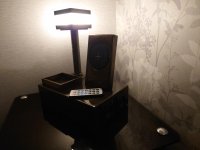
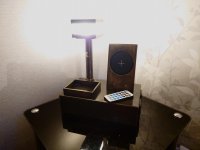
Just thought id upload a couple pics of a previous build, just to show you im serious about improving, not just a tyre kicker so to speak. I made two of these, using the dayton dma45 drivers, theres two switches on the back, one for the light, one for the internal amp, the phone charger stays on permanently while the plug is switched on. Its made from an mdf ported box which is clad in brass, all the parts on top are brass too. I just added a baffle step circuit and tbh for such small drivers it sounds quite good, has surprising bass and good clear voices. I hope you like it
Cool! remember how much work you've done over the years to be able to build something like that? 🙂 Measuring loudspeaker, simulating, interpreting the results, trying to divide sound electrically and then combine it back acoustically is pretty extensive set of knowledge and cannot be learned in a day. I'm encouraging you to take your time, learn a bit about phase, distortion, power response, listening window, group delay and other things you might not know much about and try to relate them together somehow. It is a bit daunting at the beginning but eventually you have all the pieces for the puzzle and it starts to feel manageable 🙂
If you are serious about measuring a loudspeaker read the VituixCAD manual, measurement paper and search the thread if you have questions. It is the most comprehensive way to get results without anechoic rooms the big manufacturers have.
Read Floyd Toole book since it contains almost the only scientific studies what makes a good speaker and how measurements and different metrics relate to the goodness. I haven't read it though, but have a hunch on it.
Anyway, if you give yourself some time to learn this stuff you'll learn it, it is not rocket science. Hardest thing is to find the proper information through the noise of marketing and personal bias. Try to find your way through it and remember to have fun! 🙂
If you are serious about measuring a loudspeaker read the VituixCAD manual, measurement paper and search the thread if you have questions. It is the most comprehensive way to get results without anechoic rooms the big manufacturers have.
Read Floyd Toole book since it contains almost the only scientific studies what makes a good speaker and how measurements and different metrics relate to the goodness. I haven't read it though, but have a hunch on it.
Anyway, if you give yourself some time to learn this stuff you'll learn it, it is not rocket science. Hardest thing is to find the proper information through the noise of marketing and personal bias. Try to find your way through it and remember to have fun! 🙂
Last edited:
Thank you, ill do my best, i downloaded vituixcad again today and had a quick play around with it, it seems similar to xsim in the way you add the componants, but the graphs to the right mostly are unreadable for me right now, im not sure what is good and what is bad since i dont have a reference of how they should look. Ill definately read the book you mentioned, hopefully it clears up some questions for me
I have a quick question about vituixcad though, i noticed the offsets at the side of the drivers, so with the z offset do i just add the 0.7 i got in xsim into the woofer and that compensates for the delay? Only when i added that it hardly changed the response, were as in xsim the response dropped around 3db after the 0.7 was added into the mod delay window
I have a quick question about vituixcad though, i noticed the offsets at the side of the drivers, so with the z offset do i just add the 0.7 i got in xsim into the woofer and that compensates for the delay? Only when i added that it hardly changed the response, were as in xsim the response dropped around 3db after the 0.7 was added into the mod delay window
Dameo182,
Floyd Toole's book is not going to help you at your level. It is not easy to read and deals more with sound perception and room issues than with basic speaker design. I can sum it up in one sentence for you:
Most people prefer speakers with a flat frequency response.
That's it. Four hundred and some pages later that is mainly what you will take away from it. It is more an academic study than a how-to-do-it guide.
For basic speaker design reading I would suggest starting with "Speaker Building 201" by Ray Alden. It's very readable and much more oriented to what you are dealing with at the moment.
Floyd Toole's book is not going to help you at your level. It is not easy to read and deals more with sound perception and room issues than with basic speaker design. I can sum it up in one sentence for you:
Most people prefer speakers with a flat frequency response.
That's it. Four hundred and some pages later that is mainly what you will take away from it. It is more an academic study than a how-to-do-it guide.
For basic speaker design reading I would suggest starting with "Speaker Building 201" by Ray Alden. It's very readable and much more oriented to what you are dealing with at the moment.
Last edited:
I had that feeing when i read the reviews on the book, but i was willing to give it a try, i still am but given your comment i may read it at a later date when im more advanced. I will buy and read the book you mentioned and see where im at when ive read it all. Im gonna mess about some more with vituix as i need to get these mtm's completed, i have somebody waiting to try them out on his home theatre system with a chance of purchasing them if hes happy with how they sound. So hopefully i can atleast figure out the basics of the crossover soon, even if its just so i can move onto something else ill be happy
- Home
- Loudspeakers
- Multi-Way
- Trying to finish my mtm style speakers